Rows of raised beds filled with an abundance of thriving vegetable crops are very pleasing to the eye, and this is now one of the most popular methods people choose when creating a new vegetable garden. Growing veg in raised beds not only looks neat and orderly but can also be less labour intensive and increase the chances of a successful growing season. However, there are some pitfalls and mistakes to avoid along the way, particularly when it comes to how your raised beds are constructed.
So, if you’re dreaming of transforming your underused garden with planter boxes for vegetables, keep reading to maximise your chances of success!
Why grow veg in raised beds?
There’s good reason that raised beds are now hugely popular for growing vegetables – this simple yet effective system helps to keep your garden neat, and organised, and reduces the workload required to produce a bumper crop of vegetables.
But while raised beds are a great system for growing vegetables, it is worth pointing out that they are not essential. Gardeners and farmers have been growing crops directly in the ground for thousands of years, and this straightforward technique works just as well today as it always has. So, if you don’t have the resources to build a network of raised beds, growing your crops in the ground can be equally as effective.
Whether you are starting your vegetables from seeds or planting ready plug plants, or you’re setting up a new vegetable garden from scratch or upgrading your existing plot, the question of whether to opt for raised beds or not can be a tricky one. To help you decide, we’ve put together a comprehensive list of the advantages and disadvantages of growing vegetables in raised beds.
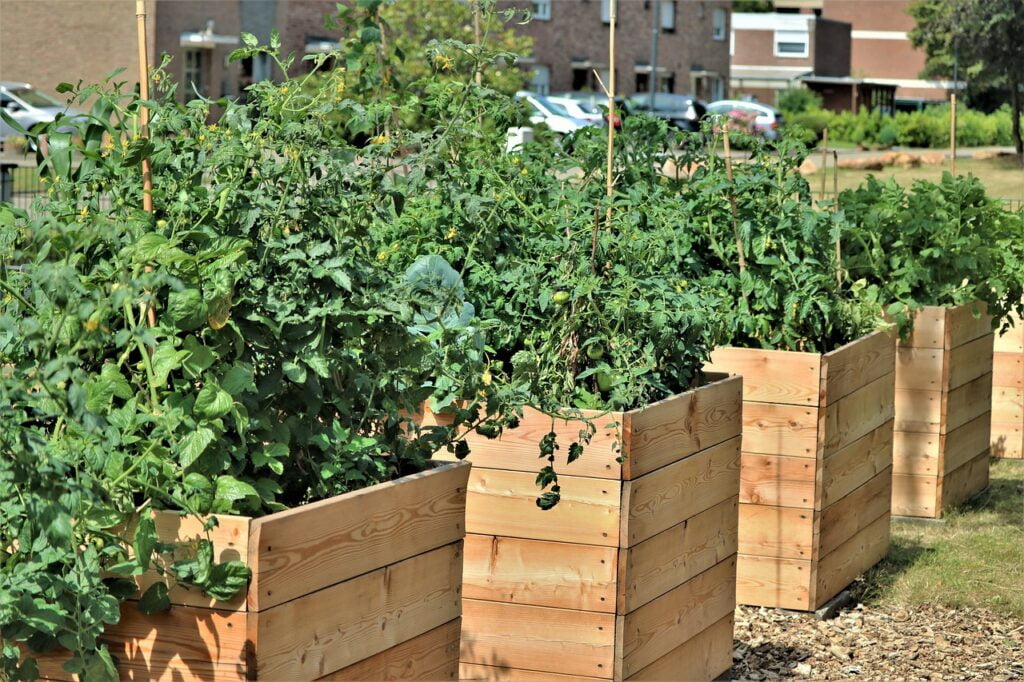
Advantages of raised planters for vegetables
Growing vegetables in raised beds offers several benefits that can contribute to healthier plants, better yields, and easier maintenance. Let’s look at why people choose to use raised beds for vegetable gardening:
- Soil quality
Raised beds allow you to control and amend the soil more easily. You can create a custom soil mix with the right balance of nutrients, organic matter, and drainage, providing an optimal environment for plant growth.
- Drainage
Elevated beds prevent waterlogging and improve drainage, crucial for preventing root rot and other water-related issues. This is especially beneficial in areas with heavy clay or poorly-draining soils.
- Water conservation
The improved soil structure in raised beds helps prevent water runoff, enhancing the efficiency of irrigation and watering practices and helping to conserve water.
- Soil temperatures
The elevated nature of raised beds allows the soil to warm up more quickly in the spring. This can extend the growing season and provide a more favourable environment for warm-season crops like tomatoes and bell peppers.
- Soil structure
As you are unlikely to walk on the growing surface of raised beds, the soil remains loose and less compacted, promoting better root development and water penetration.
- Access
Raised beds are typically built at a height that is comfortable for gardeners to reach without bending over. This makes planting, weeding, and harvesting more accessible, especially for people with mobility issues.
- Weed control
Building raised beds is a great option if you’ve got tricky perennial weeds like couch grass or bindweed in your garden soil. Starting afresh with new beds filled with good-quality compost makes it easier to keep them weed-free, and the clearly defined borders make it easier to spot and remove any weeds that do appear.
- Pest management
Raised boxes for garden vegetables are easy to fit with physical barriers like netting or covers to protect plants from pests. Raising beds for vegetables off the ground also makes it more challenging for ground-dwelling pests to reach the plants.
- Appearance
If you like order and neatness in the garden, then raised beds for veg can enhance the visual appeal of your growing areas. Crops are also closer to eye level, making it easier to appreciate the beauty of our food-producing plants.
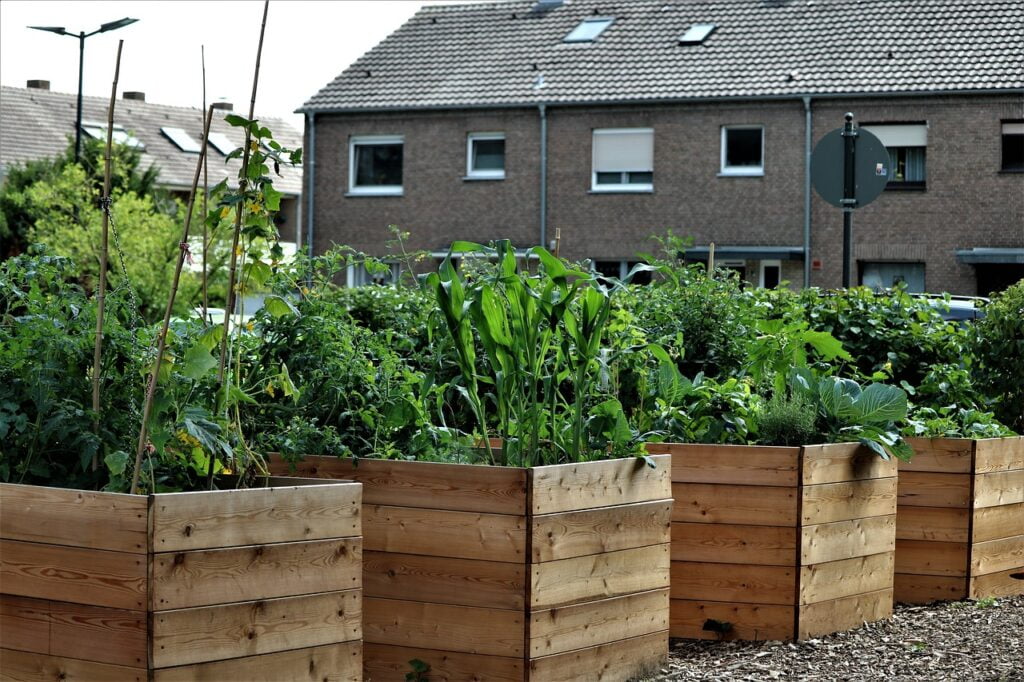
- Space optimisation
With careful planning, raised beds allow for efficient use of space, especially in areas with limited or poor-quality soil. They can be built in various shapes and sizes to fit specific areas, making it easier to plan and organize the garden layout.
Disadvantages of growing vegetables in raised boxes
While raised beds offer numerous advantages, it’s important to consider some potential disadvantages as well. Here are a few drawbacks associated with raised box gardens for vegetables:
- Cost
Raised beds can be expensive to set up, especially when compared to traditional in-ground gardening. When planning a raised bed garden, factor in the cost of materials such as timber, screws, and compost, and remember that the larger and taller the beds are, the more expensive the project will be.
- Initial setup
Building multiple raised beds or large structures can be labour-intensive, especially if the materials need to be transported and assembled. In contrast, setting up an in-ground vegetable plot can be completed quickly with minimal expense.
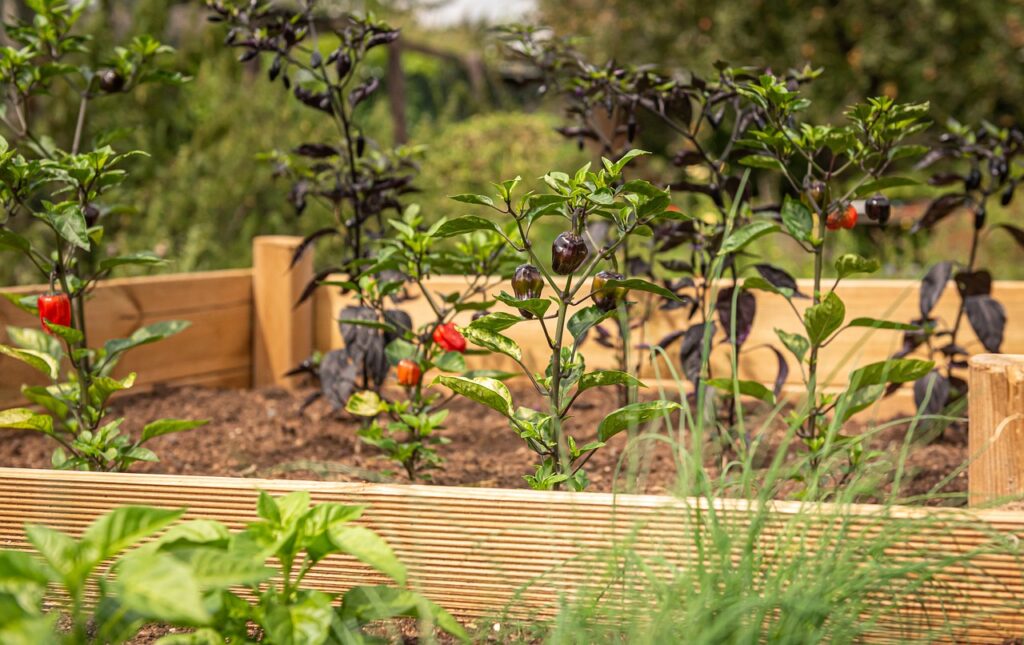
- Limited depth
Some vegetable crops, particularly those with deep root systems like carrots or parsnips, may be restricted by the limited depth of raised beds. This is particularly important when placing raised beds on concrete or paving slabs, where the roots cannot access the soil below.
- Watering requirements
Raised beds tend to dry out more quickly than in-ground gardens, especially during periods of warm weather. Monitor soil moisture levels regularly to prevent plants from drying out.
- Slugs and snails
One common issue with raised beds is that they create damp, dark hiding places for slugs and snails. At night, these creatures can quickly decimate your tenderly nurtured crops, laying waste to all your hard work.
- Overheating
While the ability of raised beds to warm up quickly in the spring is an advantage, it can also be a problem if the soil heats up too much, causing plants to become stressed during periods of hot weather.
- Restricted growing area
Raised beds provide a fixed growing area with little flexibility in comparison to an in-ground garden – if you want to expand or change your garden, the raised bed infrastructure will need to be updated. In addition, crops that like to climb upwards or sprawl across the soil will need careful management and support to keep them within their defined space.
- Food safety
While upcycling materials from other projects is a great way to keep costs down, it is crucial to make sure they are safe for growing food crops. Materials such as treated wood may contain chemicals that can leach into the soil.
- Longevity
The material that raised beds are built from will greatly affect their longevity. Wooden-sided beds are a popular choice, but constant contact with moisture can cause the wood to rot. Plastic becomes brittle when exposed to direct sunlight for long periods, and metal can turn rusty and friable.
- Weeds
While raised beds can reduce weed problems, they are not entirely weed-proof. Weeds can still infiltrate the soil from windblown seeds or through seeds in homemade compost. Once the root systems of perennial weeds take hold in raised beds, they can be difficult to eradicate.
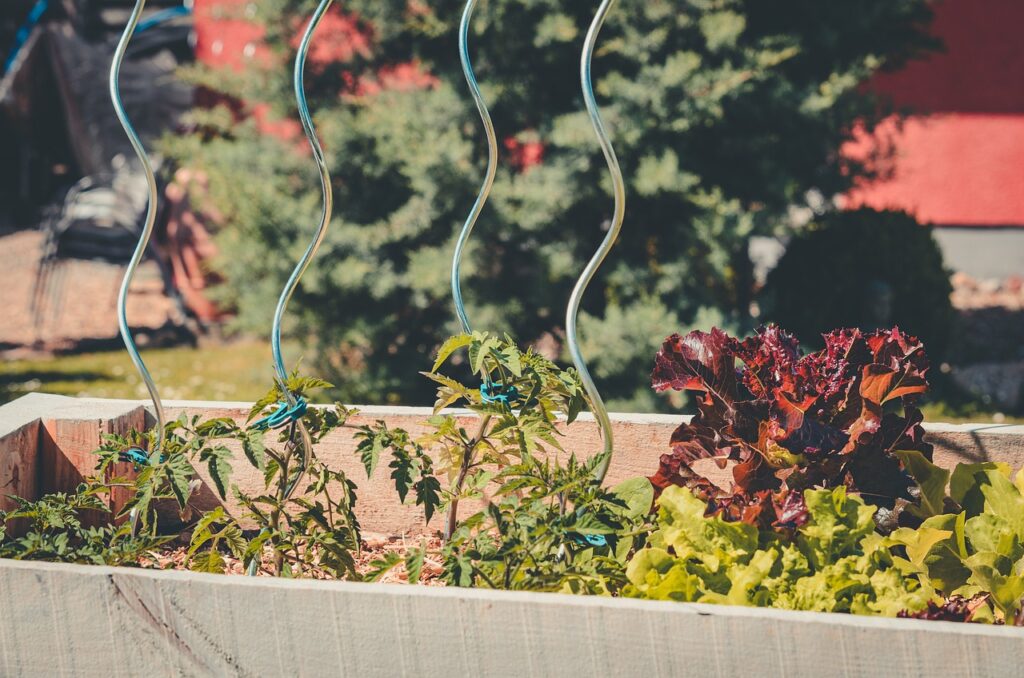
How to make raised planting beds for vegetables
So, you’ve decided that raised beds are the best choice for your vegetable garden – what’s next? Well, now it’s time to get planning! Firstly you will need to decide on the ideal material to build your beds from, then design the structure and layout of the raised beds.
Best materials for building grow boxes for vegetables
The choice of material for building your raised beds for vegetables will depend on several factors, including budget, aesthetic preferences, durability, and environmental considerations. Here are some commonly used raised bed materials, each with its own set of advantages and considerations:
- Raised wooden planters for vegetables
Wood is a natural product and can be used to create aesthetically pleasing raised vegetable beds in whatever shape, size, and configuration you wish. Hardwoods are more durable and resistant to decay than softwoods, but both will gradually deteriorate over time. Pressure-treated timber is resistant to decay, but it is essential to choose products that are marked as safe for vegetable gardening to avoid exposure to harmful chemicals.
- Composite planters for vegetables
Composite planters are made from a mix of recycled plastic and wood fibres, creating a durable raised bed that is resistant to decay and insect damage. These types of raised beds are normally purchased in prefabricated form, making them a more expensive option.
- Concrete block raised beds for vegetables
Concrete blocks or bricks can be used to create long-lasting raised vegetable beds in whatever size and configuration you desire. This option is quite labour-intensive to construct but requires very little annual maintenance to keep it in great condition. However, once in place, it can be tricky to change the layout of your concrete raised vegetable beds.
- Galvanised metal or steel
Corrugated metal or steel sheets can be used to create planters with a modern and sleek appearance. Ensure the metal is not treated with harmful coatings and take care to smooth any sharp or jagged edges. Galvanised metal is generally safe, but some may prefer not to use it due to concerns about zinc leaching into the soil over time.
- Plastic vegetable planters
Prefabricated plastic or vinyl raised garden bed kits are lightweight and easy to assemble. They are resistant to rot but may not be as durable as some other materials. Make sure only to purchase products listed as BPA-free and safe for gardening.
- Straw bales
Straw bales are a fun, easy, and cost-effective way to create raised beds. A simple four-sided structure made from four bales can be used to grow a surprising amount of veg, and the plants will benefit from nutrients from the straw as it decays. This system will need replacing every year as the bales break down, but the decomposing straw is great for mulching veg beds or bulking out your compost pile.
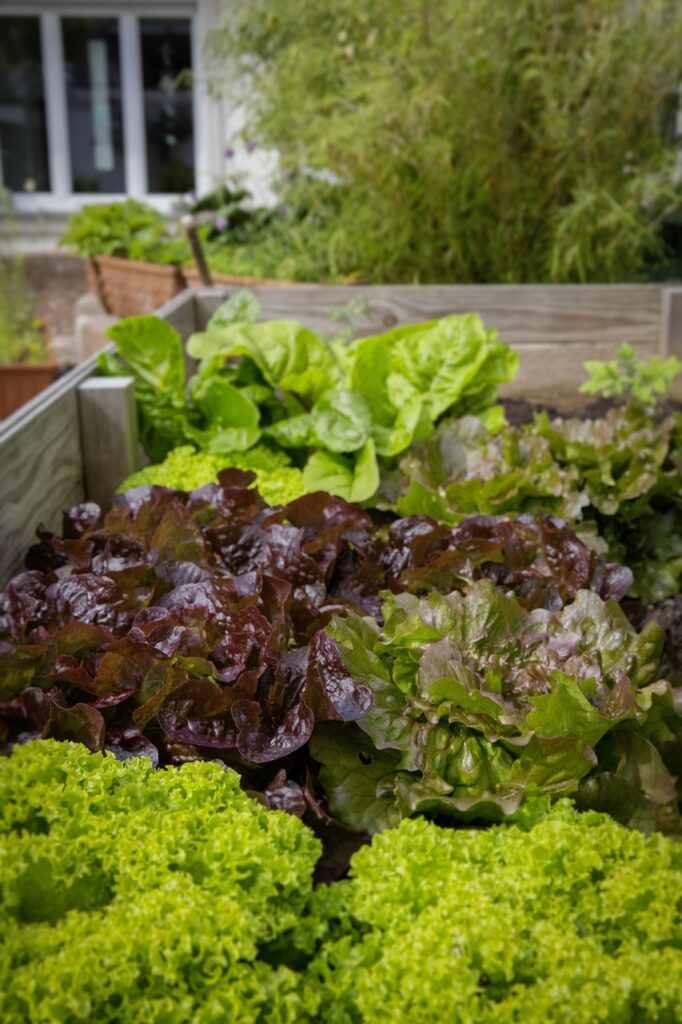
How big should raised beds for growing vegetables be?
Now for the fun part – planning the layout of your raised bed system! Remember that raised beds for vegetables don’t necessarily have to be square or rectangular – your design can be tailored to fit the available space, such as L-shaped beds to make the most of tight corners and U-shaped beds for easy access.
You may notice that most raised veg bed gardens are straight-sided rather than curved. There is no reason why not to include curved edges in your design, but make sure it is feasible to construct using the material you have chosen. In addition, remember that we tend to plant rows of crops in straight lines, so a curved design may not make the most of your available space.
When planning the size of each raised bed for vegetables, it is essential to take the following measurements into account:
- Width: The width of a raised bed is crucial because it determines how far you can reach into the bed from either side without having to step onto the soil. A common recommendation is to keep each bed between 3 to 4 feet wide (about 0.9 to 1.2 metres). This allows you to easily access the centre of the bed from either side without compacting the soil.
- Length: The length of each raised bed can vary based on the available space and your gardening needs. However, it’s practical to keep the length within a manageable range, such as 6 to 12 feet (about 1.8 to 3.6 metres). Any longer than this and you’ll soon get tired of walking around from one side to the other.
- Height: The optimum height for your raised beds will depend on factors such as the type of vegetables you plan to grow and your own comfort and mobility. A common height range for raised beds is 12 to 24 inches (about 30 to 60 centimetres) – this is deep enough for most vegetable crops. Taller beds can be beneficial for people with mobility issues or for certain crops with deeper root systems.
- Pathways: Don’t underestimate how much space you will need to leave between raised beds for pathways. A pathway width of at least 18 inches (about 45 centimetres) is usually sufficient, allowing easy access for wheelbarrows.
One final consideration when planning your raised bed vegetable garden is the localised climate conditions in your garden. Consider factors such as sunlight exposure, prevailing winds, shaded spots, and water drainage to optimize growing conditions for your plants.
Do you need a weed membrane with raised beds?
It was once common practice to line raised beds with weed membranes, with the aim of preventing weeds from growing up from the soil underneath. However, in recent years it has been discovered that not only is weed membrane ineffective when used in this way, but it can also be detrimental to soil health and the environment.
Ideally, raised beds should be located directly on the ground, so that insects and microorganisms can move freely from the soil into your raised bed compost. This creates an intricate network that supports the root systems of the vegetable crops, promoting vigorous growth and reducing the risk of pests and diseases. Placing a weed membrane at the base of the planter stops larger organisms from moving freely, leading to a lack of biodiversity in the soil.
In addition, weeds coming up from the soil below raised beds are not normally a problem – the compost acts as a thick layer of mulch, and only the most persistent weeds can travel upwards to the surface. Over time, weed membranes can start to deteriorate and may release microplastics into the soil, something which all gardeners are keen to avoid.
How to fill a raised veg bed
There is nothing quite as satisfying as filling your lovely new raised veg beds! This final step makes all the planning and hard work worth it, as the moment arrives to create the perfect planting medium for your vegetable seedlings.
The ideal soil mix for raised vegetable beds is made up of 50% good-quality topsoil and 50% composted organic matter and other soil amendments. Although you can purchase premixed soil for raised beds, it can work out cheaper to mix it yourself, especially if you need a large quantity.
To do this, start by locating a source of good-quality topsoil – this should be dark brown with a rich, earthy smell and soft, crumbly texture. Avoid topsoil that is excessively sticky, sandy, or grey in colour, as this is likely to be subsoil with low levels of nutrients. Remember that topsoil will make up around half of the total volume required to fill your raised beds.
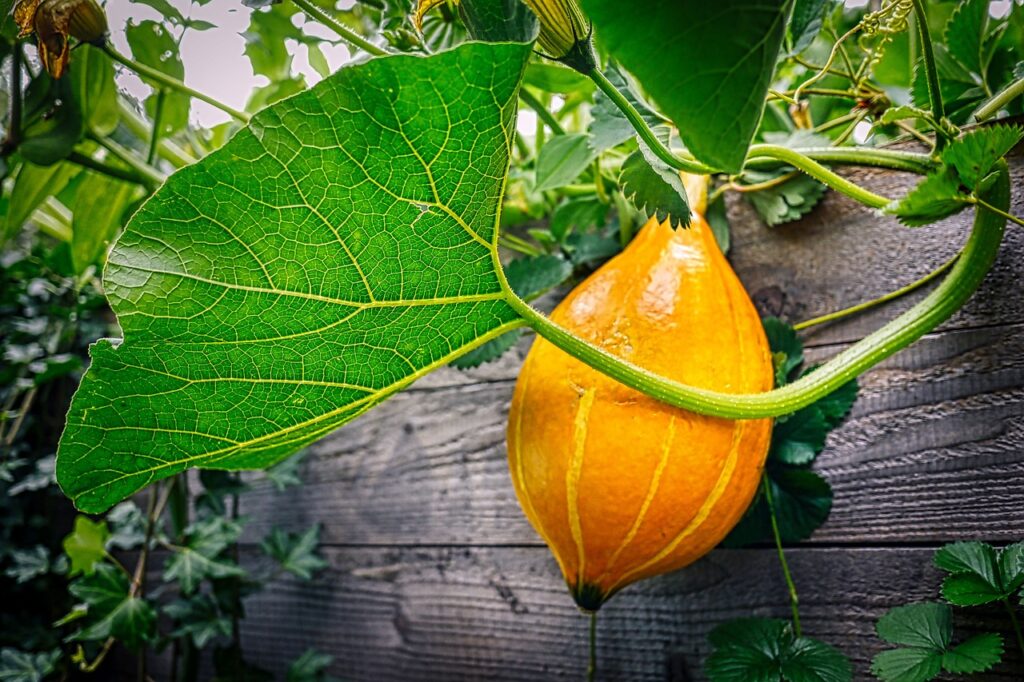
Next, add a source of good-quality composted organic matter – around 30% of the total finished volume. This can be homemade compost if you can produce enough, or green waste or mushroom compost are cost-effective alternatives. Composted animal manures are an excellent source of nutrients for growing vegetables, but it is important to verify that it is free from traces of herbicides that can stunt the growth of your plants.
Finally, it is time to supercharge your raised bed soil mix with whatever soil amendments you can lay your hands on. Good options include worm castings, well-rotted tree bark or woodchip, shredded leaves, biochar, or mycorrhizae. If you don’t have enough to make up the final 20% of the raised bed soil mix, simply add in extra compost to make up the difference.
Fill each raised bed to 2-3 inches below the top with this raised bed soil mix then water well – you will notice that the level drops substantially, so top it up as required. It is not unusual for the soil in raised beds to settle a lot during the first growing season, so you may find that it needs extra soil mix at regular intervals.
Irrigating a raised veg planter
If you can, it is a good idea to install irrigation for your raised bed vegetable garden at the time of construction as this is simpler than adding it at a later date. It also allows you to hide unsightly pipes from view, maintaining the beautiful aesthetic of your new raised veg planters. Of course, there is nothing wrong with watering by hand if irrigation is not an option, but simple irrigation systems are cheap, easy to install, and save precious time and water.
The two most common types of irrigation for vegetable beds are drip irrigation and soaker hoses. These both deliver a steady supply of water that is absorbed slowly into the soil over a set period each day. This minimises water wastage through evaporation or runoff, keeping the deeper layers of soil damp even when the surface appears dry.
In addition to irrigation, mulch is a great way to improve water conservation and prevent raised beds from drying out. A 2-4 inch thick layer of mulch on the soil surface reduces evaporation and also helps to suppress weed growth.
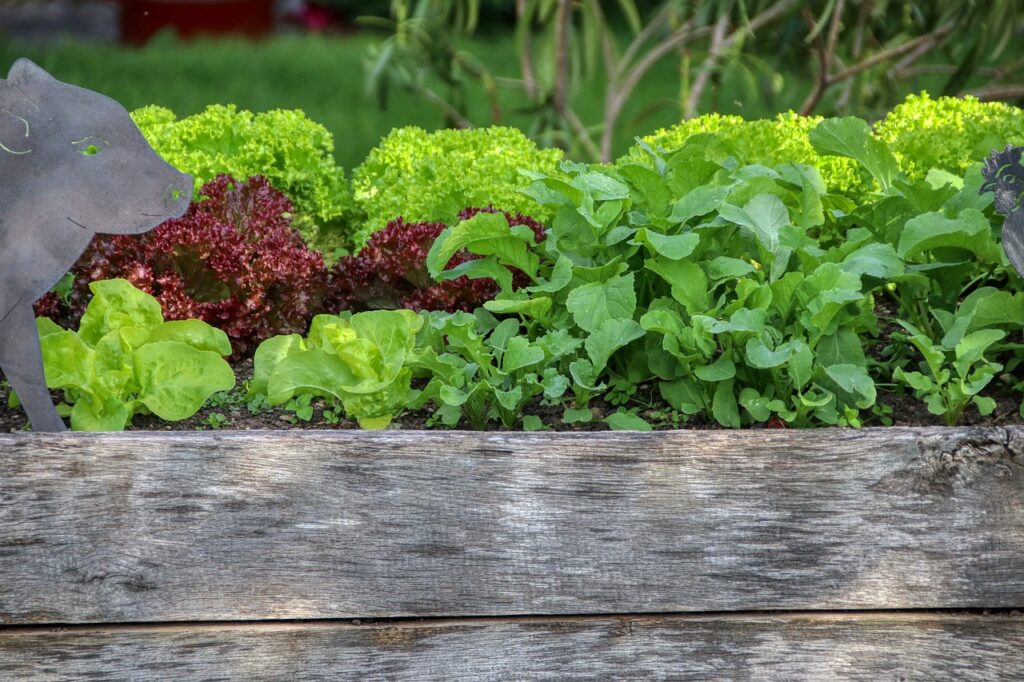
Plant supports and pest control in elevated vegetable planters
When creating a raised bed vegetable garden, it is important to bear in mind how plants will be supported and protected from pests. Some prefabricated vegetable planters come fitted with systems that allow for plant supports and row covers to be slotted neatly into place when necessary. If you’re building raised beds from scratch, you will need to decide how best to configure plant supports and pest control systems in each bed.
One popular option is to use plastic piping to create curved hoops over each bed. These are held in place by short posts fixed to the side of the raised bed or pushed into the soil. The hoops can be removed and replaced as needed, providing support for garden fleece or netting at the relevant times during the growing season.
In terms of plant supports, a trellis or row of canes can be placed along the middle of each bed for taller crops such as beans, peas, and tomatoes. Low-growing plants can be grown on either side of these crops, where they will benefit from the shade during the peak of summer. Alternatively, poles can be sunk into the ground at either end of each bed, allowing wire or string to be tied between them to support vining crops.

